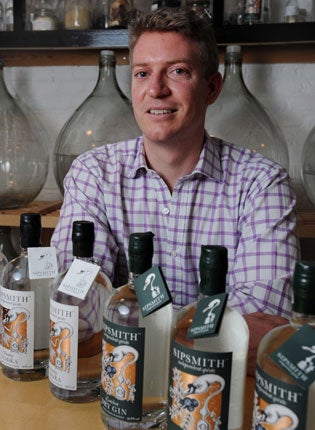Posh gin from London garage bucks the trend

The history of London’s gin industry is peppered with tales of small-scale producers boiling up heady spirits in tiny sheds. So it was natural that the authors of an attempt to reinvent the practice would set up their venture in a tin-roofed suburban garage in Hammersmith.
Behind the double doors of this small workshop in a west London residential street bubbles Prudence, the first new copper still to be built in the capital for 189 years. It has been put to work by two childhood friends who sank their life savings into reinvigorating the production of London Dry Gin, in the city from which it gained its name.
Far from conjuring up the dissolute chaos which Mother’s Ruin brought to impoverished 18th-century Londoners – famously depicted by the painter William Hogarth – the producers of Sipsmith London Dry Gin are catching the attention of a more discerning clientele.
From their bespoke “micro-distillery”, the founders of the suitably Dickensian-sounding company, Fairfax Hall and Stamford Galsworthy, have secured regular orders. The bar of the Dorchester Hotel (where a Sipsmith gin and tonic costs £12.94), the Harvey Nichols department store and The Ivy restaurant have become loyal customers. All deliveries are made by Mr Galsworthy on the back of his moped.
Mr Hall, 36, who gave up a job as a strategist for the drinks giant Diageo to pursue his dream of becoming a small-scale distiller, said: “It has been a labour of love. The trouble was that it had not been done in such a long time that nobody even knew how to grant us a licence. When we finally got one from HM Revenue & Customs it had to be handwritten on a piece of paper.”
The success of the first artisanal gin to be produced in London for nearly two centuries is part of a wider boom in demand for premium versions of the juniper-flavoured spirit. Euromonitor International, the market research company, estimates that mainstream high-end brands, including Tanqueray or Bombay Sapphire, now account for 30 per cent of global gin sales. In Britain, where sales of gin have generally stagnated in recent years, the premium brands have bucked the trend and now have a 17.5 per cent share of the market. Globally, the market for posh gin is predicted to grow at about 5 per cent a year.
But while the big producers are each pumping out 30,000 litres of gin every day (and only one company, Beefeater, still makes London Dry Gin in London), production at Sipsmith, which also makes a vodka, has a more intimate scale. Each £24 bottle comes with a batch number that can be checked on the company’s website, allowing customers to see how the weather was when it was being made.
The nondescript exterior of the company’s garage headquarters conceals a dazzling tangle of gleaming copper piping and boiling vessels, alongside jars of botanical flavourings from orange peel to bitter Spanish almonds. It resembles a scene from a Jules Verne novel, or a medieval apothecary.
Prudence began production this summer and was made-to-order by a specialist firm in Bavaria. It produces only 250 bottles from each two-day-long production run and uses spring water from a source of the Thames. A secret recipe of 10 gin flavourings, including liquorice and coriander, is left to meld overnight before being passed once through the swan neck of the still – a technique known as “one-shot gin” that harks back to the drink’s 1700s heyday.
Indeed, the 1751 Gin Act, introduced to crack down on a vast Georgian cottage industry of backroom stills, where gin was often adulterated with turpentine and sulphuric acid, left the founders of Sipsmith with a series of problems.
In order to get their distilling licence, the two men, who grew up together in Cornwall before being reunited in America while working in the drinks industry, had to get a special dispensation from rules which ban any still with a capacity of less than 1,800 litres. Prudence holds just 300 litres.
With their gin due to go on sale in Selfridges at the end of the month, the pair believe they have hit on a consumer thirst for a small-scale spirit with a story behind it. Mr Hall said: “If I had tried to persuade Diageo that they should make a real London gin with Thames spring water in batches of 250 using a real copper still they would have had a heart attack. Our idea of export is selling a bottle outside the M25.”
Join our commenting forum
Join thought-provoking conversations, follow other Independent readers and see their replies
Comments